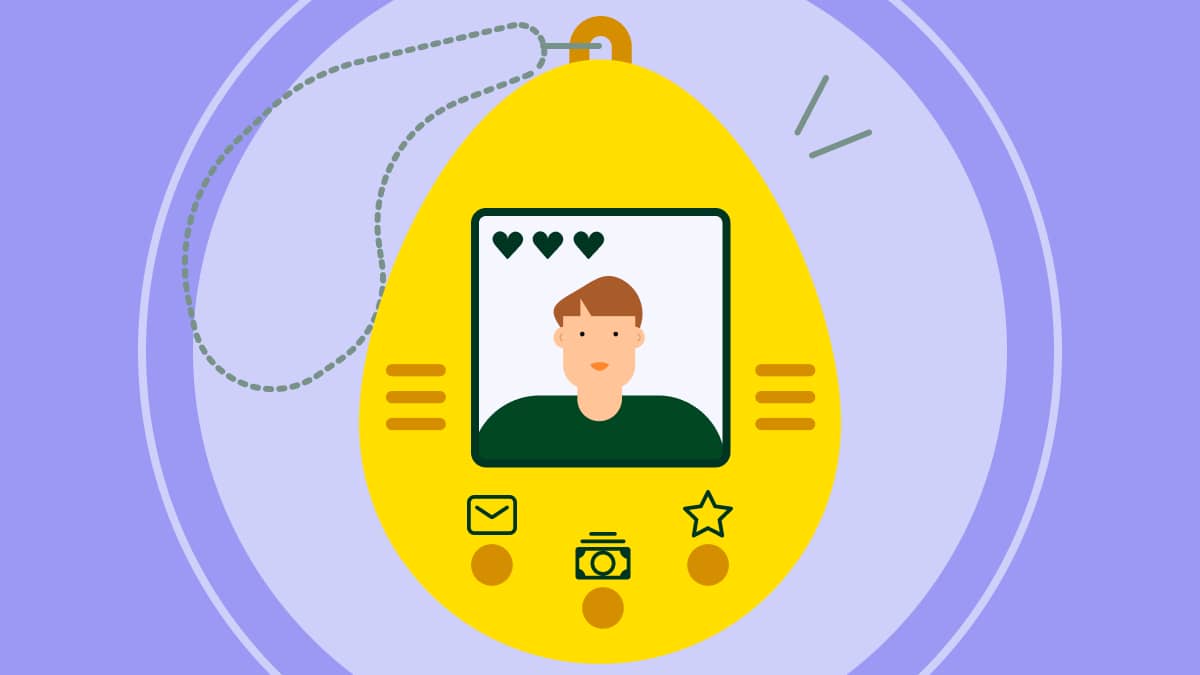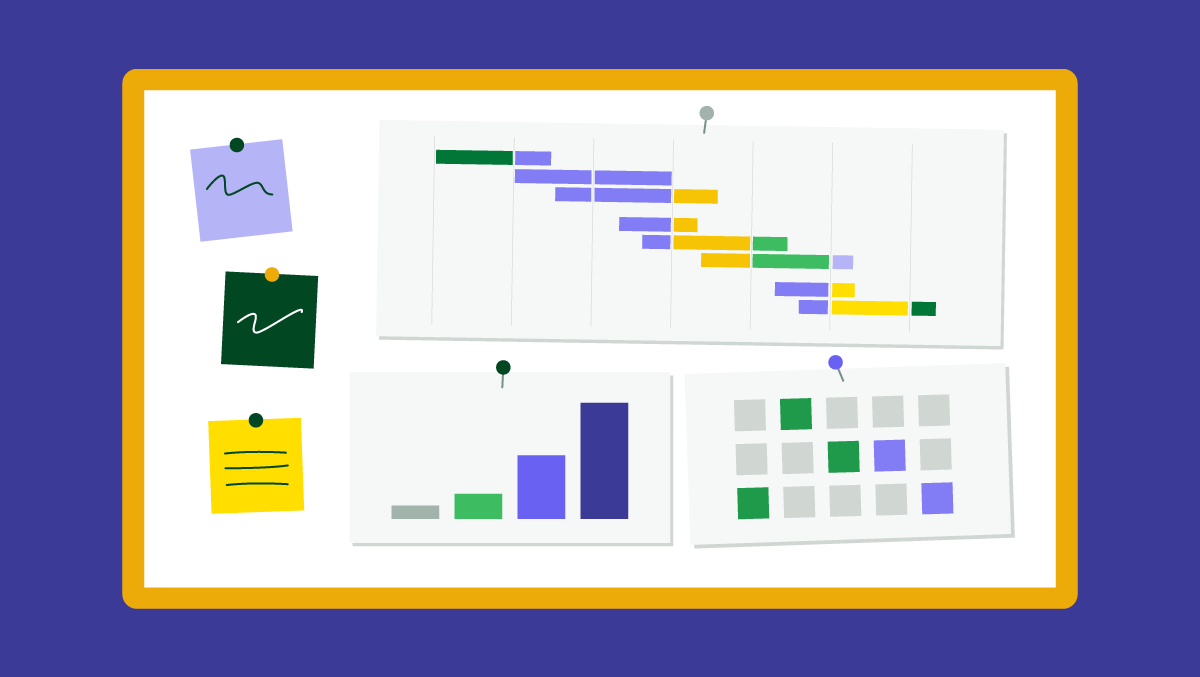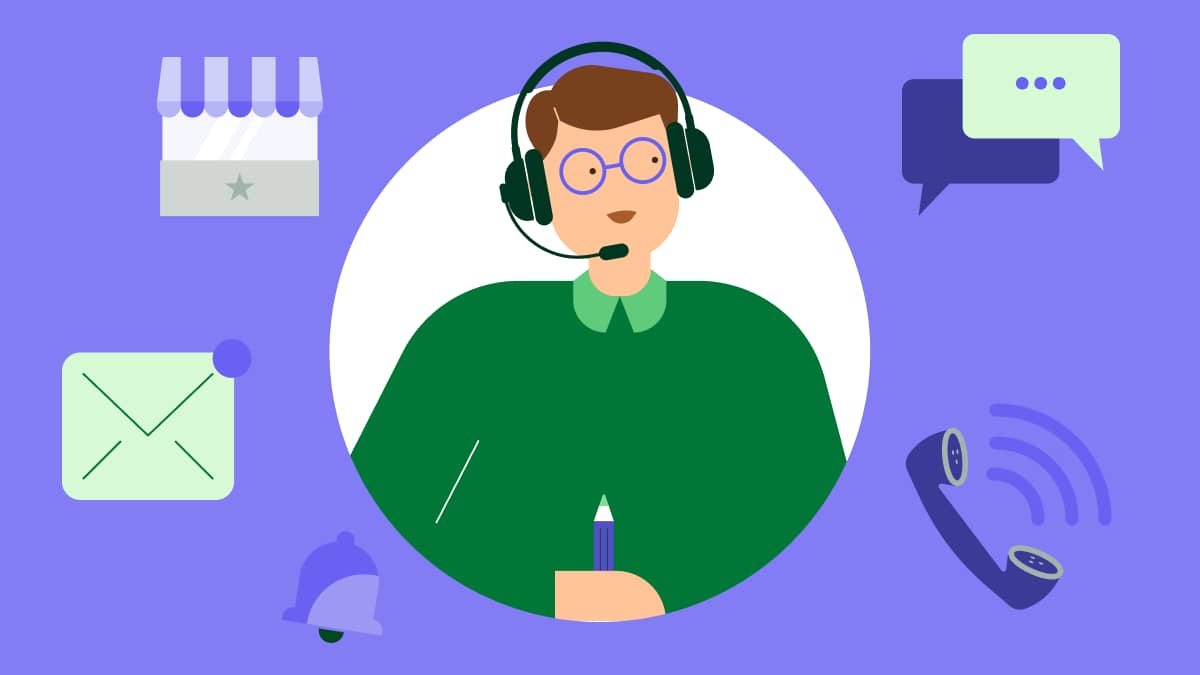Customer marketing transforms one-time buyers into brand advocates who drive growth.
For small businesses, it means shifting focus from the high costs of chasing new prospects to maximizing the value of customers who already trust the brand – and are easier to sell to.
In this article, you’ll discover seven effective customer marketing strategies to generate predictable revenue and sustainable business growth from your existing customer base.
Key takeaways from customer marketing
Customer marketing focuses your efforts on existing customers who already trust you instead of only chasing new prospects.
Focusing on existing customers drives more revenue through upgrades or selling additional products while keeping acquisition costs low.
Programs like referrals, loyalty rewards and VIP treatment turn satisfied buyers into advocates and prevent churn.
Pipedrive tracks customer history, automates follow-ups and helps you segment by value so you can focus on marketing strategies that drive the highest returns – try it free for 14 days.
Customer marketing definition: Customer marketing takes a customer-centric approach by focusing marketing efforts on the existing customer base. Your business encourages current customers to buy more, stay loyal and refer others
While many businesses focus on customer acquisition, this approach overlooks easier revenue opportunities.
Customer marketing focuses on your current customers, who already know your business. They’ve experienced your value first-hand and may be more willing to re-purchase.
According to Smile.io research, customers who buy from your online store once have a 27% chance of buying again. Their second and third purchase probability goes up further.
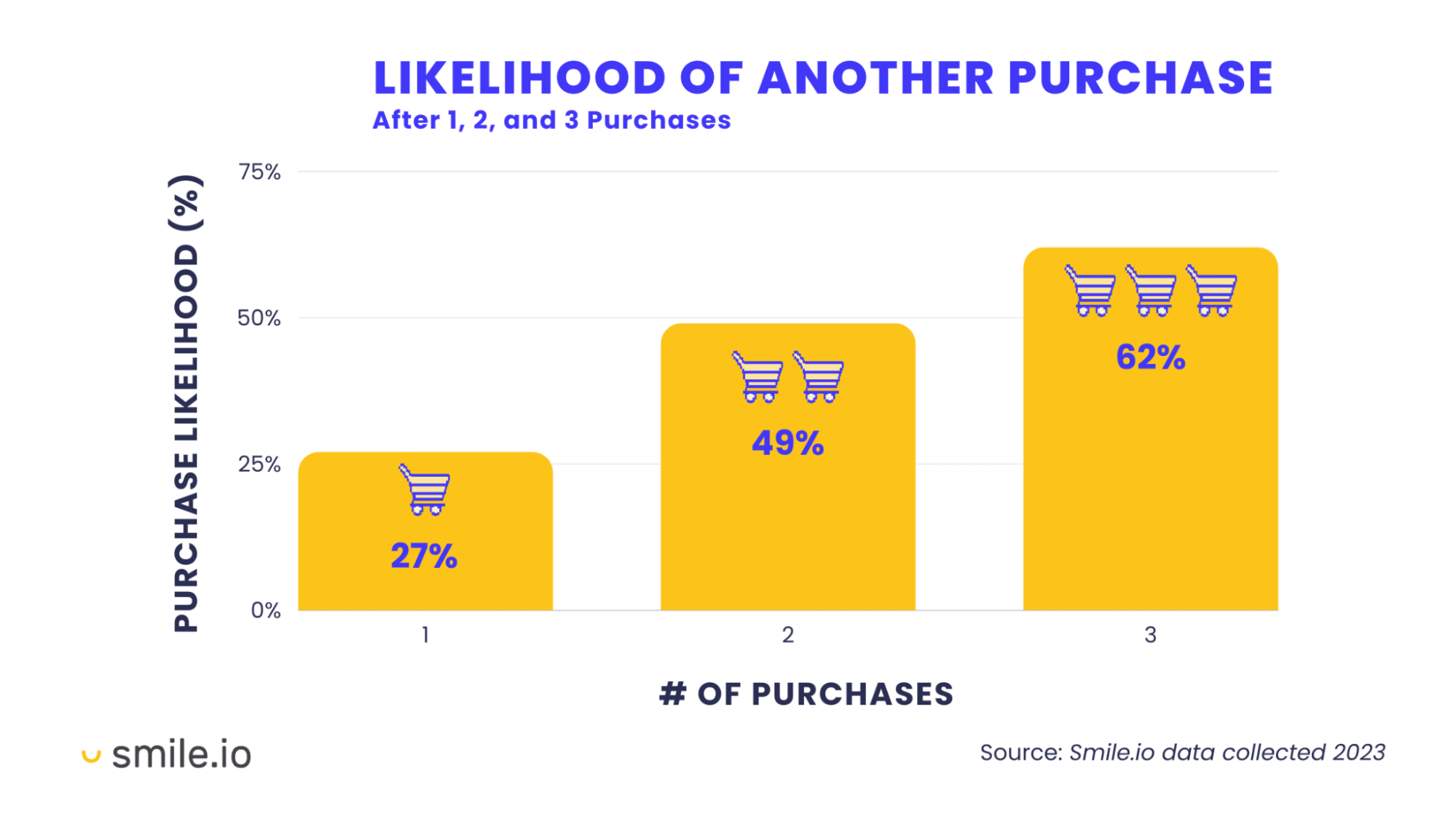
Your existing customers become more valuable over time, with each purchase building trust and familiarity with your business.
Still, you can’t treat all customers the same way. Someone who bought from you once needs different attention than a customer who’s been with you for years.
There are three key elements to effective customer marketing based on your buyers:
Segmentation – segment according to people’s customer engagement and purchase behavior
Personalization – create messages that address specific customer needs
Progression – strengthen customer relationships and move them toward higher value
You need to understand where each customer sits in their journey with you. Then, create clear paths that guide them toward higher value and deeper engagement.
Benefits of customer marketing
Customer marketing gives you a head start over acquisition. You skip the awareness and consideration stages altogether.
The customer journey becomes shorter and you start with warm leads instead of cold leads every time.
Download our customer journey map template
Here are some of the benefits of customer marketing for small businesses:
Higher profitability | Why it works: Your existing customers are more profitable than new ones. |
Cost-effective growth | Why it works: Existing customers require less marketing budget and effort. |
Revenue expansion | Why it works: Existing customers are easier to upsell and cross-sell. Example: A three-person sales team uses your basic software plan at $50 per user. When the team doubles, your customer marketing manager sends an email offering additional seats. They upgrade immediately, adding $150 in monthly revenue. No re-pitch required – they already trust your solutions. |
Competitive protection | Why it works: Satisfied buyers become loyal, improving customer retention rates. Example: Your customers get cold emails from competitors with promotions, but are reluctant to change service providers. A 20% off offer in HR software isn’t attractive when they’ve already built their processes in your system. They’d have to start over and lose the relationship they’ve built with your team. |
Business insights | Why it works: Long-term buyers give you better customer feedback and data. Example: Say you run a survey and find out most of your customers prefer using the mobile app. So you improve the mobile experience, which helps you sell more effectively to similar sales prospects. |
Now that you understand why customer marketing works, learn why it’s different from lifecycle marketing in a fundamental way.
Customer marketing vs. lifecycle marketing
Customer marketing and lifecycle marketing differ in timing.
Customer marketing starts after the first sale. You increase customer satisfaction, build loyalty and move customers toward advocacy. The main focus is developing the post-purchase relationship for retention and repeat purchases.
Lifecycle marketing starts before potential customers know you exist. You create marketing for every customer touchpoint along the journey – from brand awareness to advocacy.
Customer marketing is one function of lifecycle marketing, while the latter spans the whole journey.
Most businesses need both approaches for successful growth. Yet, small-scale business owners often focus on acquisition and miss out on crucial customer retention opportunities.
7 successful customer marketing strategies for SMBs
Customer marketing strategies work best when they match your current business stage and customer needs..
Here are some successful marketing strategies you can use.
1. Customer onboarding campaigns
A customer onboarding campaign is a sequence of emails that guides new customers.
You design these emails to educate customers or help them achieve milestones. For example, helping them set up their first sales pipeline or importing their contact list.
The main goal of these emails is to move customers from “I’m just signed up” to “I’m getting value”. If customers don’t get value quickly, they may churn.
An onboarding campaign can have the following email sequence:
Setup guide email (how to get started with the software or service)
First milestone email (e.g., create an email campaign or import contacts)
SMB benefit: Onboarding campaigns work better for small businesses that need to educate customers. If customers can understand your offer without guidance, onboarding may be unnecessary.
Here’s an example of an email from Pipedrive’s onboarding sequence:
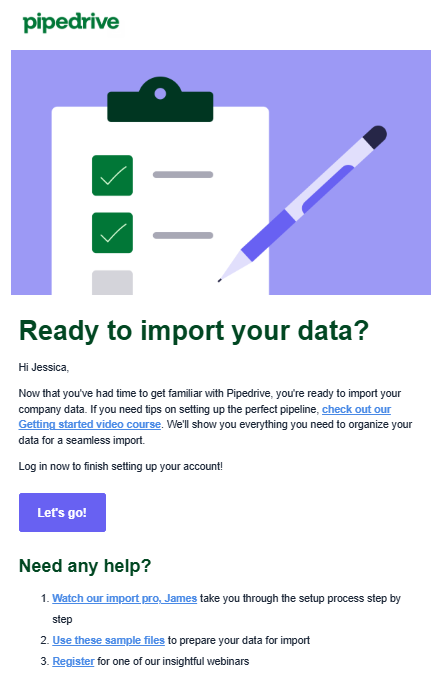
This is a milestone email to help customers import data. Rather than making customers log into their account and navigate to the feature, Pipedrive provides a handy “Let’s go!” button.
The message also includes a link to a video tutorial. This gives customers additional support if they need more guidance on the import process.
2. Upselling and cross-selling
Upselling and cross-selling marketing help you promote upgrades and complementary products to get more value from customers.
Upselling campaigns promote premium versions of products your customers already use. For instance, you may market a pro plan to customers who are on your software’s basic plan.
Meanwhile, cross-selling campaigns promote additional or new products that complement customers’ purchases. For example, a buyer who’s upgraded to your pro plan may need your consulting services.
SMB benefit: Upselling and cross-selling increase customer lifetime value without adding acquisition costs. Higher lifetime values mean you can invest more in your business growth
Take Grammarly, the writing assistant that marketing teams can use to create content faster. Here’s how it subtly upsells to its customers:
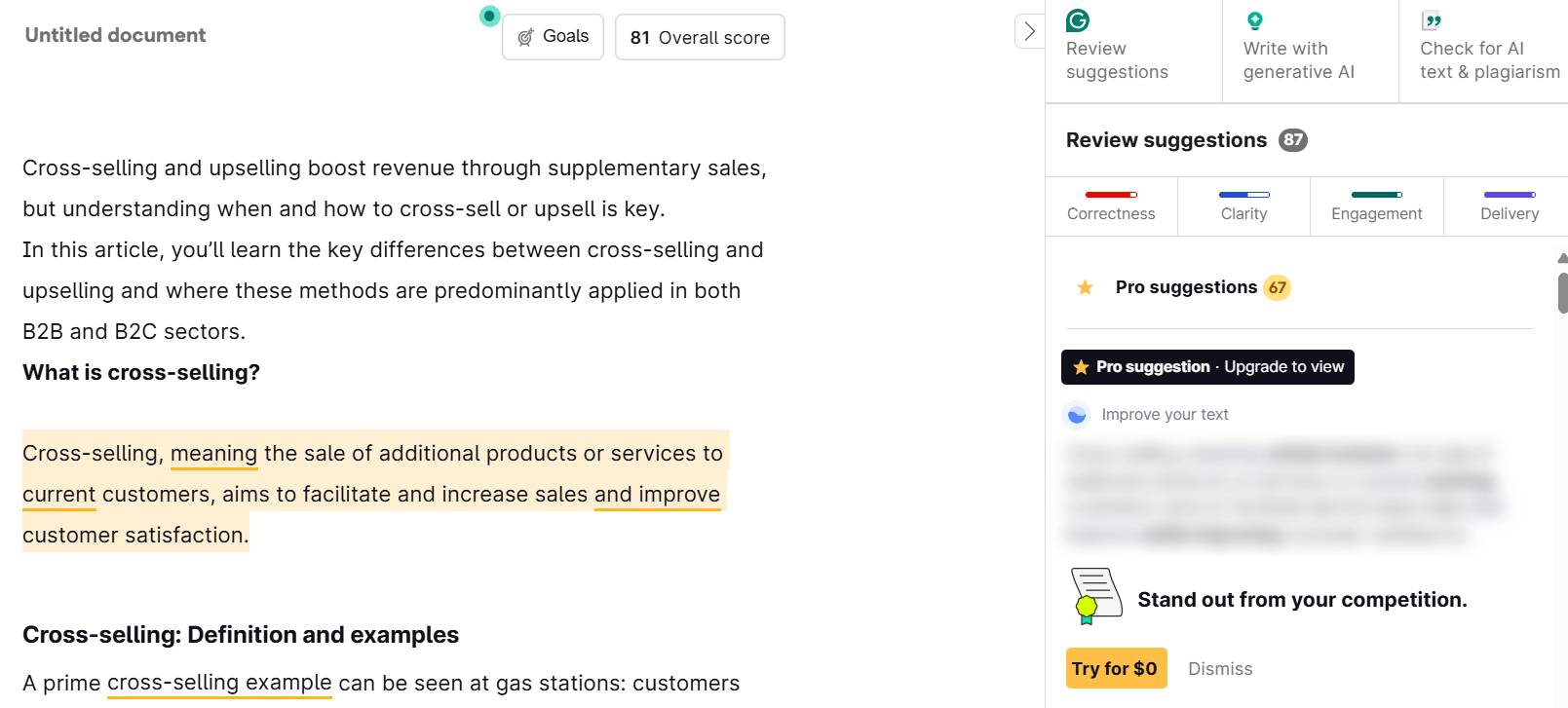
When you use the free plan, Grammarly catches basic spelling and grammar errors – providing immediate value. Pro suggestions appear greyed out as you write, promising to improve your content quality.
SMBs can instantly see how a product upgrade benefits their limited resources, which makes the sales conversation easier.
3. Customer loyalty programs
Customer loyalty programs are reward systems that give customers incentives to keep buying.
They typically involve points, tiers or membership benefits. You structure these programs so customers earn rewards after reaching a specific milestone.
A few examples for a small SaaS provider can include:
“Pay yearly, get 15% off”
“Refer a client, earn $100 credit”
“Spend $,5,000 yearly, unlock VIP support”
SMB benefit: Loyalty programs are critical for SMB management and success because you can turn occasional customers into predictable revenue. Users earn rewards for repeat purchases, making them less likely to switch to competitors.
Take how an Amazon Prime subscription can help small businesses get supplies delivered quickly at no extra cost.
Amazon Prime represents a new approach to loyalty programs. Instead of using point accumulation, it creates loyal customers through upfront membership fees.
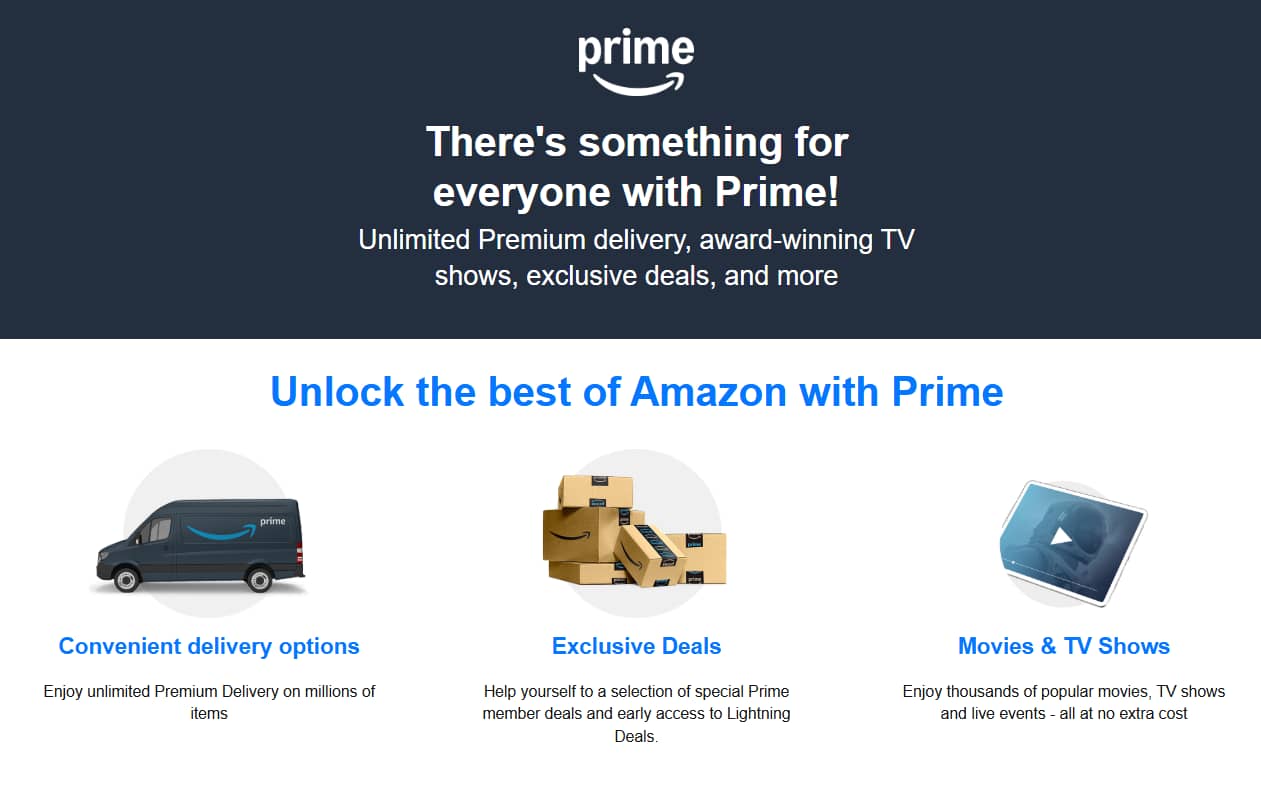
The subscription offers fast shipping, exclusive discounts and access to other Prime products.
Because of these benefits, Prime members may be more motivated to buy from Amazon. They’ve already paid for the benefits, so they’ll want to maximize their investment.
If loyalty works for Amazon, you can make it work for your valued SMB customers.
4. Customer advocacy programs
Customer advocacy programs turn your happiest customers into brand ambassadors who promote your business through content creation and customer stories.
This content may come in the form of:
Video testimonials
Educational blog posts
Social media mentions
Advocacy initiatives recognize a simple truth. Happy customers often enjoy sharing their wins. Your job is to give them easy ways to share those stories.
SMB benefit: Advocates create authentic marketing content. Sales prospects trust real customers more than ads, making social proof more effective for SMB sales than any campaign you could run.
Atlassian owns project management tools like Jira and Trello, which small teams can use to track tasks and collaborate on projects.
Here’s how Atlassian’s community champion program turns customers into advocates
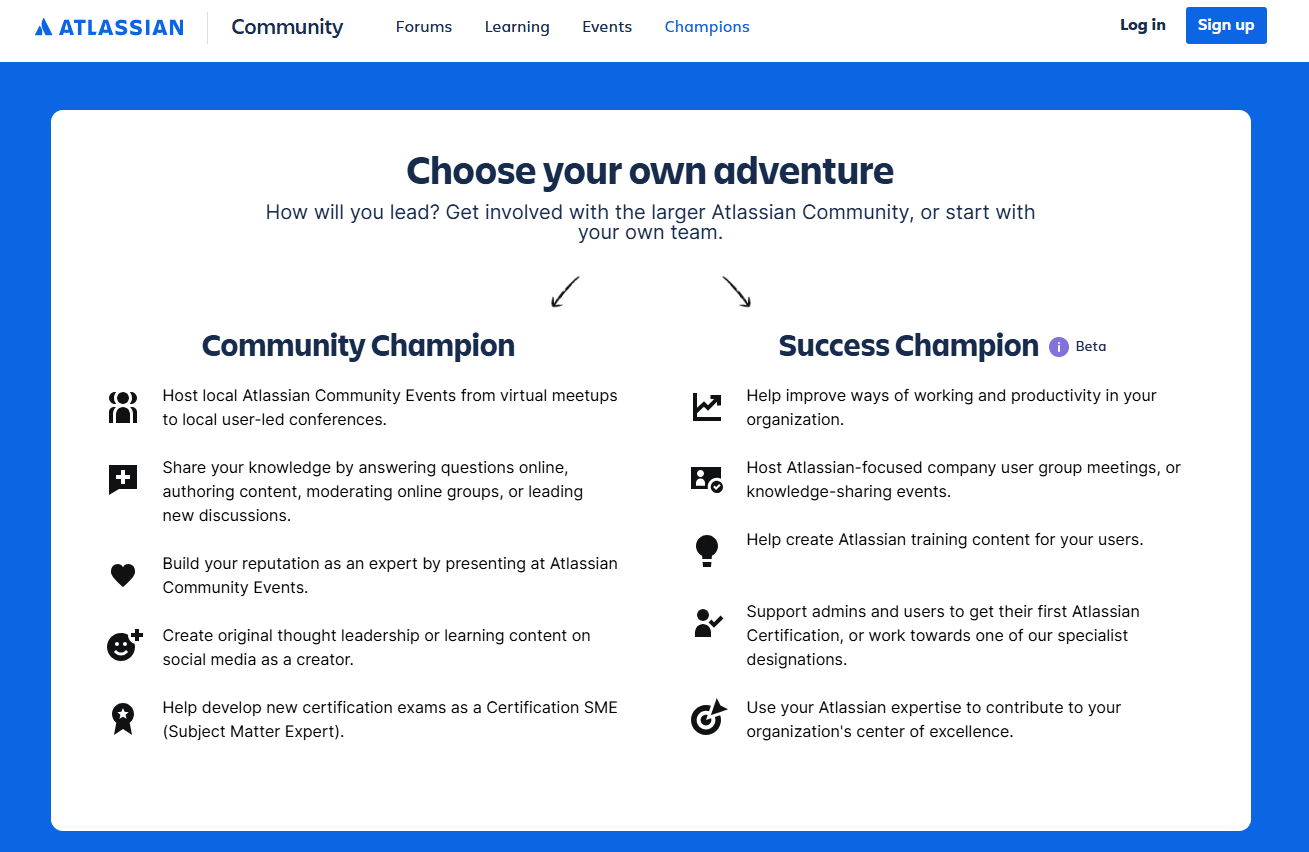
Atlassian looks for customers with deep product expertise. The company gives these champions free course vouchers, exclusive champion-only spaces and even direct access to the Atlassian team.
Champions create educational content about Atlassian products in return. They host webinars, mentor other users and speak at conferences.
This advocacy feels natural because it builds on real expertise and genuine enthusiasm – an ideal scenario in the tech industry.
5. Referral programs
Referral programs are a word-of-mouth strategy in which customers refer others to your product or service.
Referrals involve giving both the referring customer and the new customer a reward. This reward often comes in the form of:
Free months of service
Discounts on future purchases
Free products or bonuses
Gift cards to popular retailers
A referral program works because it leverages the existing trust between customers and their networks. When someone gets a recommendation from a trusted source, they’re more likely to pay attention to it and dismiss any sales pitch.
SMB benefit: Referral programs are one of the most effective ways of acquisition. Instead of paying upfront for advertising that may not deliver results, you only pay when someone brings you a new customer.
Consider Dropbox. Small businesses can use the cloud storage service to collaborate on documents and back up important data.
Here’s how Dropbox’s referral program makes both existing and new customers willing to take part:
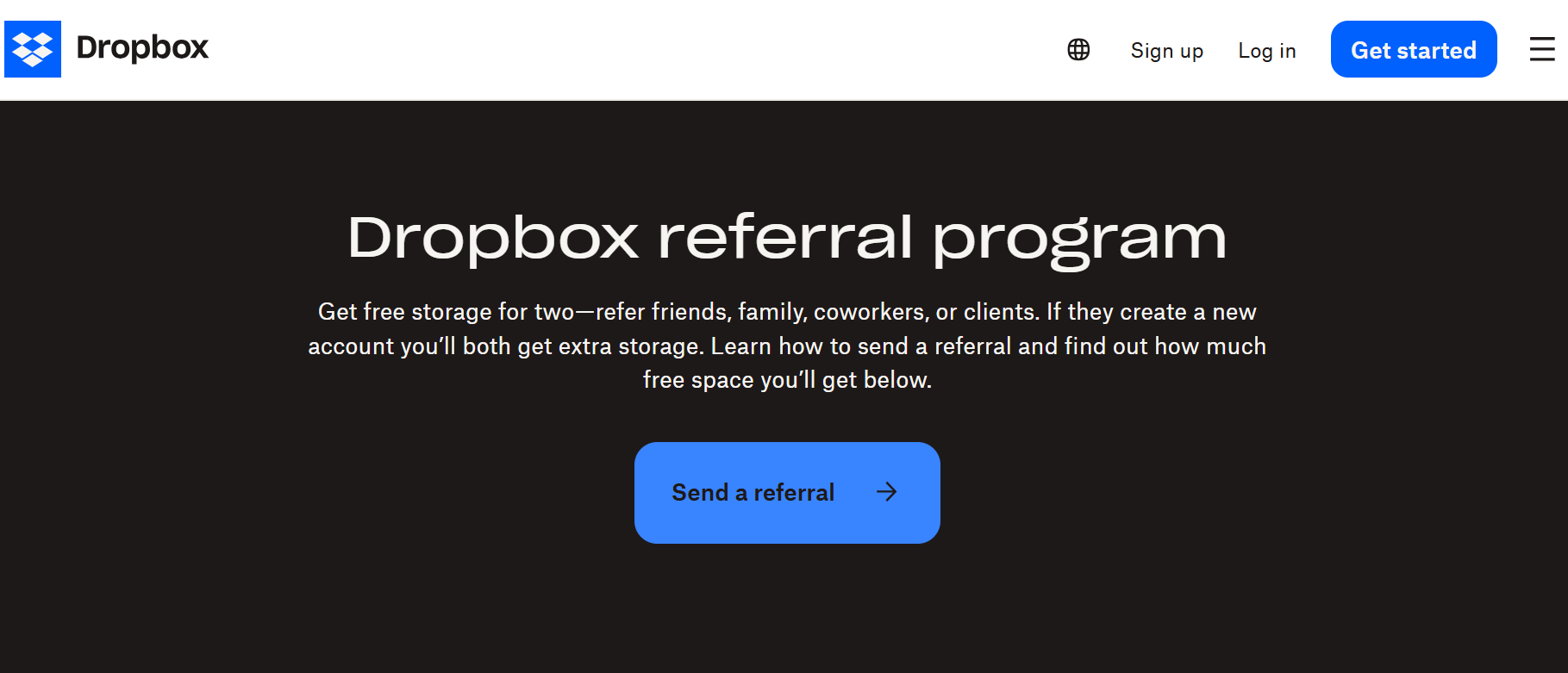
You just need to sign up for Dropbox and send an email or referral link to your contacts. If one of them joins Dropbox, you both get an extra 500 MB (Basic users) or 1 GB (Plus users) of space.
Everyone benefits from this interaction. Dropbox gains a new customer and users win more storage space.
This makes the referral process feel mutually beneficial rather than a transaction.
6. Win-back campaigns
Win-back campaigns try to re-engage customers who stopped using your product or service.
It often involves sending emails with compelling offers to convince customers to buy from you again. The email may start with a simple “we miss you” message and escalate to special discounts.
Win-back strategies work because former customers are easier to convert than new customers. They already know your business and have experience with your product.
SMB benefit: When you have a limited marketing budget, reaching out to former customers is more cost-effective than acquiring new ones. You’re essentially skipping the awareness stage and going straight to conversion.
At the same time, by understanding why customers left, you prevent future customer churn.
Canva’s design tool is popular among small businesses looking to create professional-looking marketing materials.
Here’s how the brand re-engages customers:
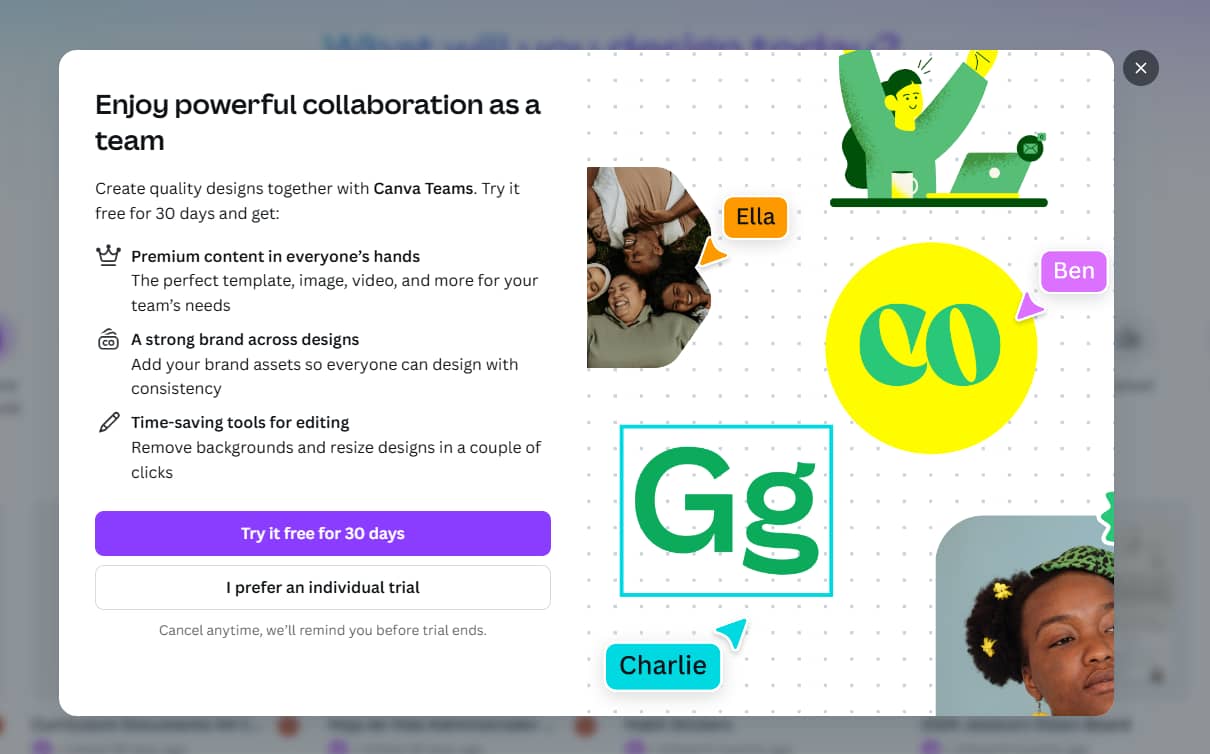
After you’ve been on the free plan for a while, when you log into Canva, a pop-up offers you 30 days of premium features for free. This achieves several purposes:
Removes the cost barrier that made you downgrade
Reminds you of premium features you’re missing
Creates urgency with a time limit
Provides value without risk
When you can remind customers of specific benefits, your win-back strategies become more compelling.
7. VIP/exclusive programs
VIP programs provide exceptional customer experiences to high-value customers.
The value of these customers is often based on their spending or strategic importance. Losing one usually costs far more than losing an average customer. They represent a considerable amount of your revenue, so it makes sense to invest in extra resources to keep them happy.
Keeping high-value customers is more about risk management. Not an optional customer service enhancement.
SMB benefit: Retaining high-value customers becomes even more critical for SMBs. If you generate $500k a year and a customer account for $75k, losing them means losing 15% of revenue.
Small businesses rely on Microsoft tools for daily operations – from email to file sharing. Here’s how its Premier Support program provides VIP treatment to high-value clients:
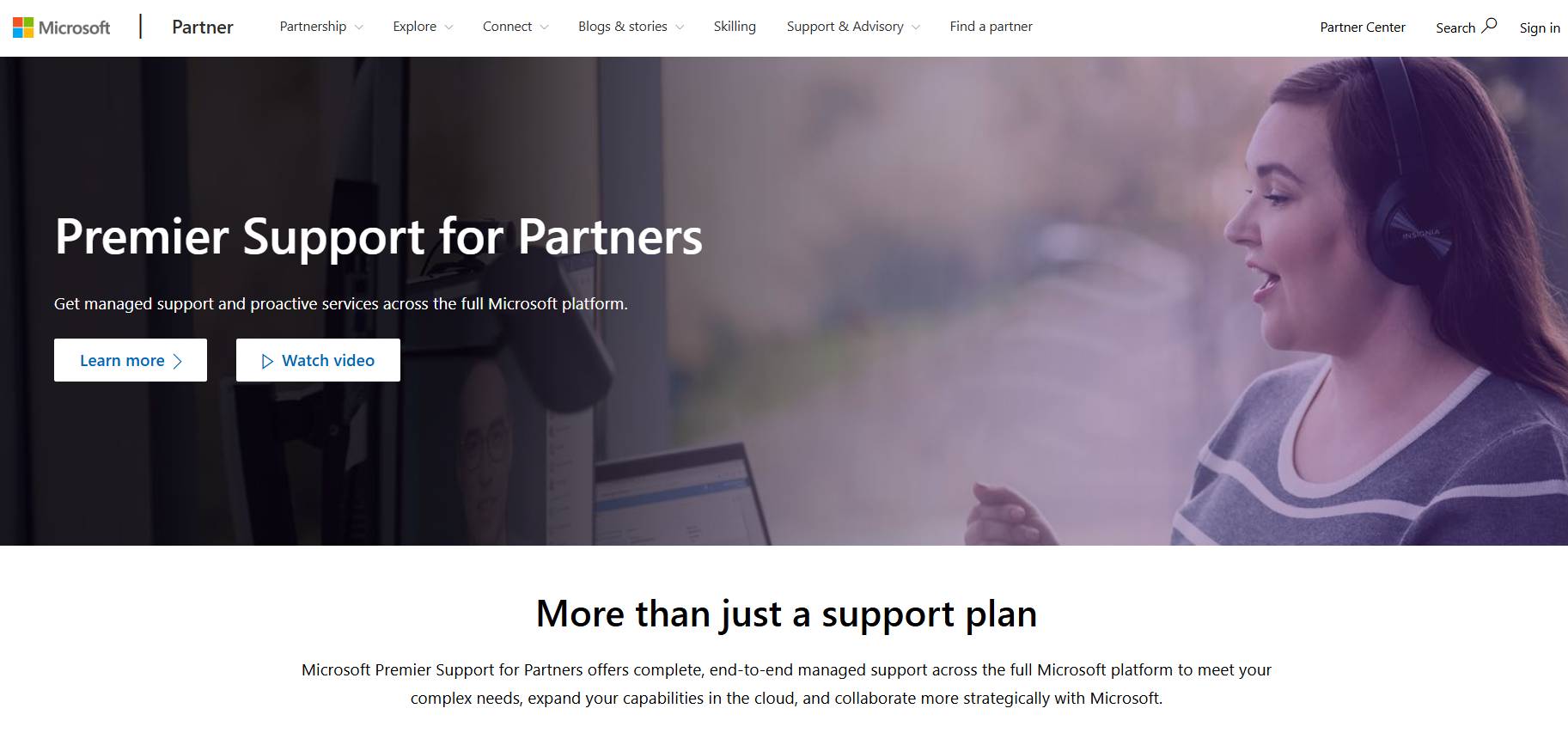
The program offers a dedicated account manager, faster response times, workshops and in-depth customer support.
A key component of this strategy is recognizing that the cost of extra services is far less than losing high-value customers and that VIP marketing efforts help preserve their lifetime value.
How to implement customer marketing strategies with Pipedrive
While Pipedrive’s customer relationship management (CRM) software manages your sales pipeline and tracks customer interactions, it can also power your customer marketing efforts.
The platform streamlines email campaigns, identifies high-value customers and segments audiences for targeted marketing.
Here are three ways Pipedrive supports some of the customer marketing strategies outlined in this article.
1. Automate email sequences with Campaigns
Pipedrive’s Campaigns feature automates your email campaigns and customer communications directly from your CRM.
With this customer marketing solution, you can send onboarding sequences or win-back marketing campaigns.
Create an automated email campaign by going to Campaigns > Automated campaigns > + Campaign.
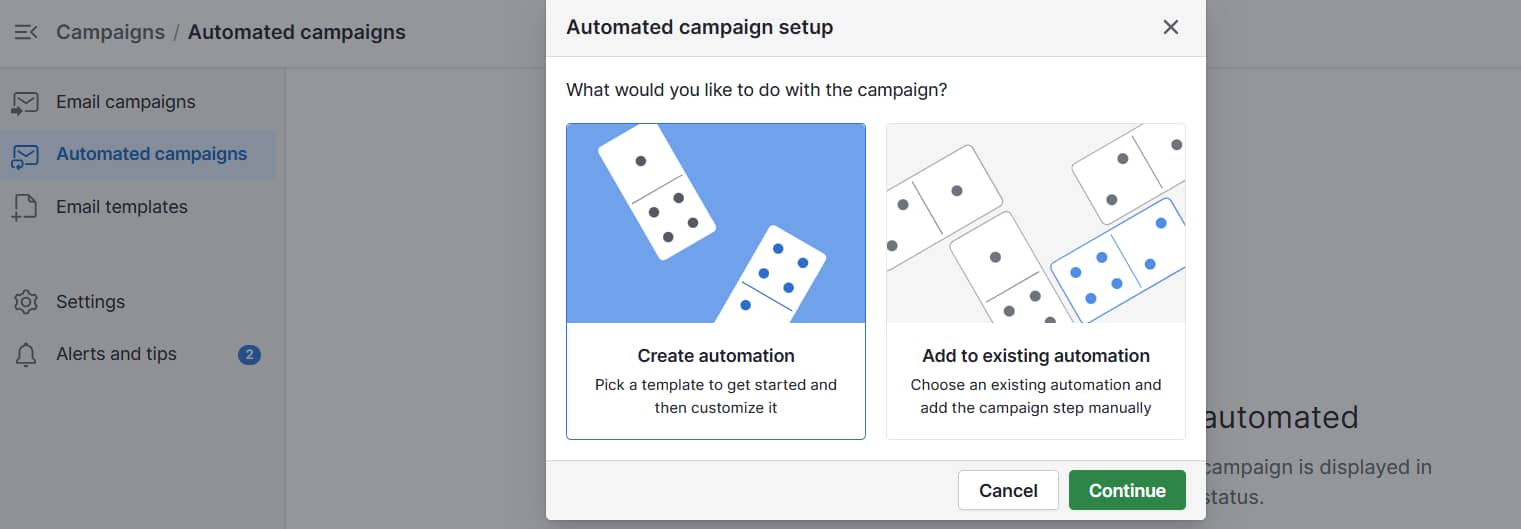
Enter the trigger, condition and action. For example, to build a welcome sequence that includes tutorial videos on day one, set:
Trigger as “deal won”
Condition as a label for “new customer”
Action as “send email immediately”
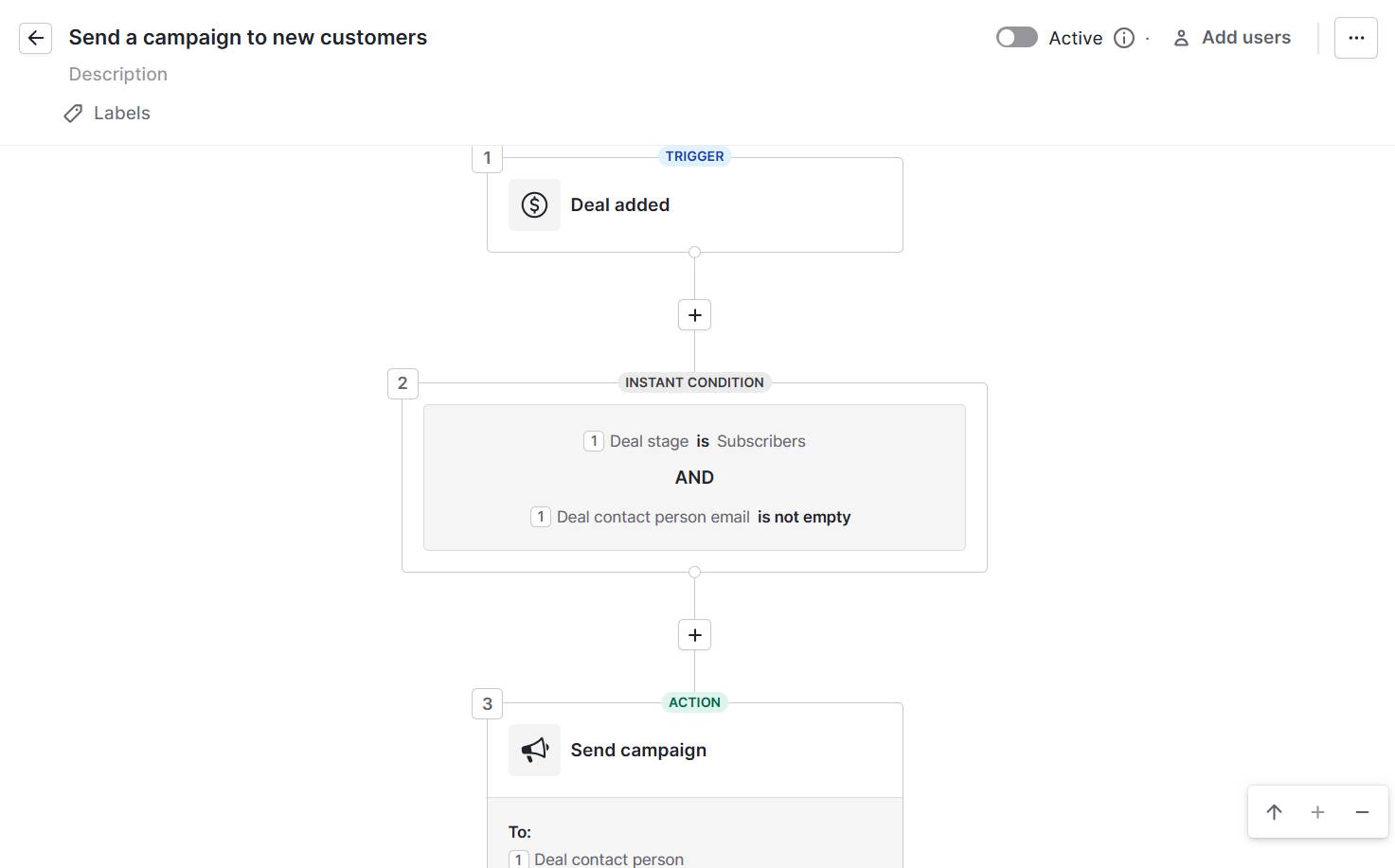
Once your campaign is live, you can track open rates and click-throughs to see which messages resonate best with your customers.
The drag-and-drop builder makes it easy to design professional emails. You can customize your messages by adding your brand colors, images and CTA buttons.
Pipedrive in action: Trainify, a corporate education company in Latvia, struggled with disconnected email marketing and CRM tools. Every campaign required the company to export contacts from its CRM into its email tool first. This process wasted hours each week and created errors when the data didn’t sync properly.
After switching to Pipedrive’s CRM and adding the Campaigns feature, Trainify consolidated all contacts on a single platform. Email campaigns now pull data directly from the CRM without manual exports or imports, saving the company two hours every week.
2. Track customer value with deal data
Pipedrive stores metrics and information about every customer sale in your deal records.
You can see purchase history and product preferences all in one place. The deal records help you identify which customers spend the most in your business. You can spot patterns like:
Customers who buy X product every Y months
Upgrades and downgrades
Customers approaching renewal dates
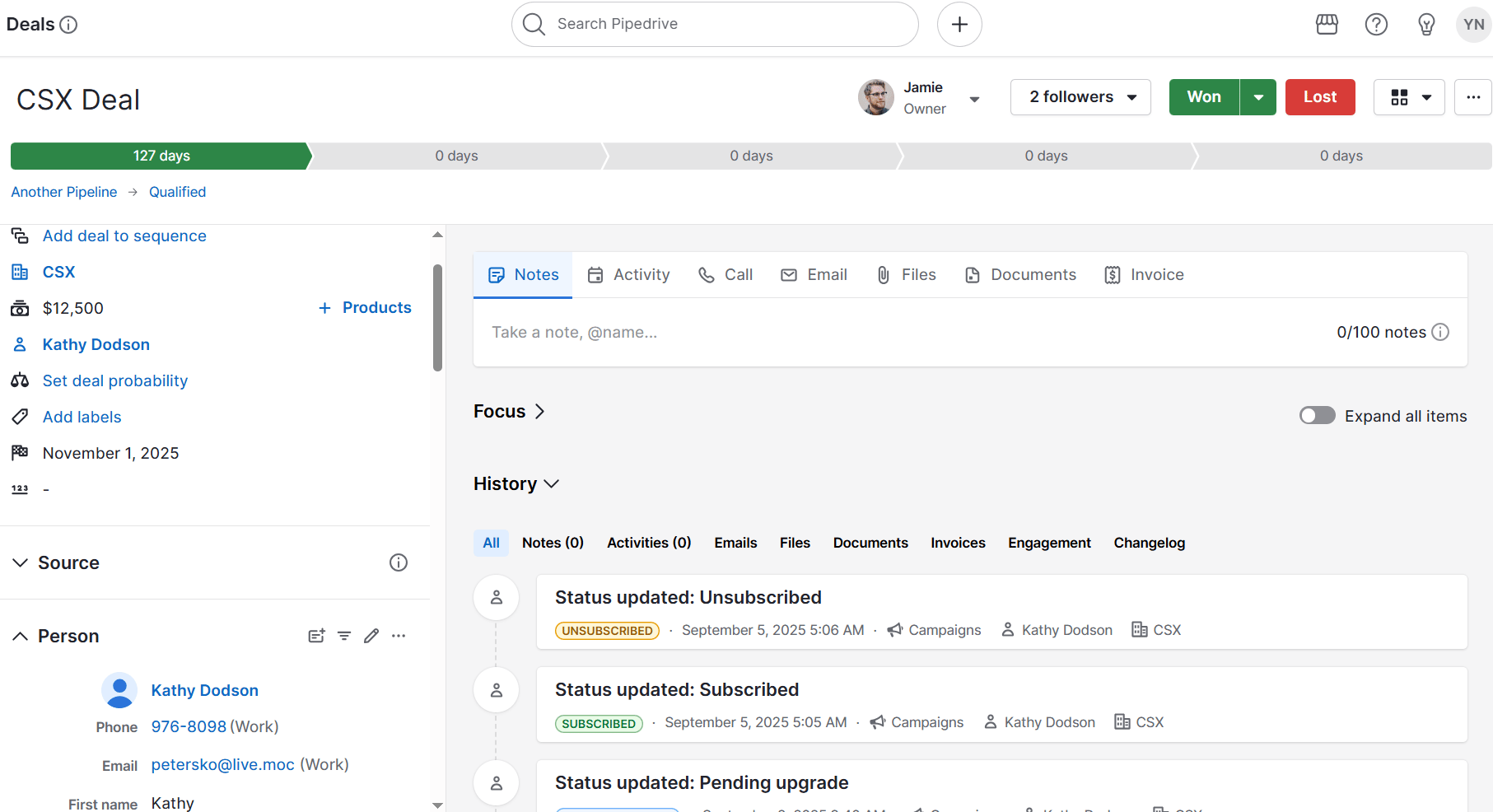
From these insights, you can identify upsell and cross-sell opportunities.
Example: You might notice a client’s marketing team has grown from five to 10 people. Their current plan only covers five seats, which signals a perfect moment to reach out about upgrading.
Pipedrive in action: Snug, a subscription rental housing platform, relied on spreadsheets to track customer data. This manual process made it difficult for the sales team to access and act on information.
With Pipedrive, everything moved into a centralized system. Custom fields and automation helped Snug’s small sales team prioritize leads more effectively,boosting its prospect list growth by 40% a month.
3. Segment customers with labels and filters
Pipedrive lets you organize customers into groups using labels and custom filters.
You can create segments based on purchase behavior, engagement levels or customer value. Think of these segments as customer personas that help you send the right message to the right people.
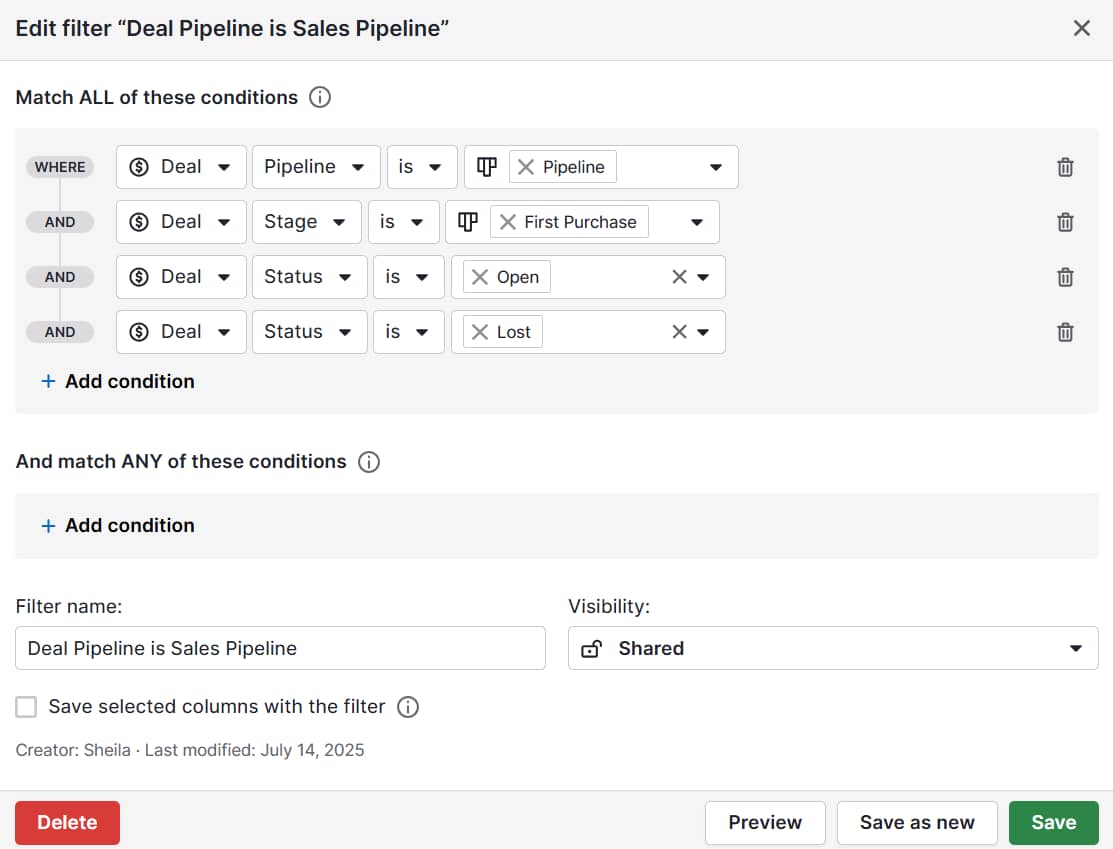
Example: You might create labels like “VIP customer”, “upsell ready” or “at risk of churning”. Apply these labels to deals or contacts based on the patterns you spot in your customer data.
When you need to run a specific campaign, filter your contact list by label to target exactly the right people.
Pipedrive in action: UK-based marketing agency Creative Race struggled to monitor prospects’ movements across the pipeline, leading to missed sales opportunities and poor forecasting.
With Pipedrive’s customizable fields, CreativeRace built targeted customer lists and maintained accurate data across its dashboards and reports. The payoff:a 600% year-over-year boost in client acquisition.
Final thoughts
Customer marketing can increase revenue per customer, reduce churn and turn satisfied customers into brand advocates – all while keeping marketing costs low.
Instead of chasing new, costly prospects, you focus on those who already trust and know your value.
Pipedrive gives you the tools you need to implement effective customer marketing strategies. You get automated campaigns, customer segmentation and value tracking in one platform.
Sign up for a 14-day free trial to grow your SMB through your existing customers.
